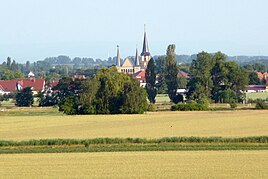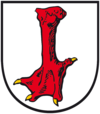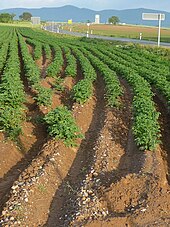Geinsheim (Neustadt)
|
Geinsheim
City of Neustadt an der Weinstrasse
|
|
|---|---|
| Coordinates: 49 ° 18 ′ 16 ″ N , 8 ° 15 ′ 22 ″ E | |
| Height : | 113 m above sea level NHN |
| Area : | 11.74 km² |
| Residents : | 1954 (Jan 11, 2012) |
| Population density : | 166 inhabitants / km² |
| Incorporation : | 7th June 1969 |
| Postal code : | 67435 |
| Area code : | 06327 |
|
Geinsheim (red) within the district of Neustadt
|
|
|
View of Geinsheim
|
|
Geinsheim ( pfälzisch Goise) is the Vorderpfalz and is a district since 7 June 1969, local district 10 km north-westerly independent city Neustadt on the Wine Route in Rhineland-Palatinate incorporated.
geography
The Palatinate street village of Geinsheim is, as its name suggests, in the so-called “ Gäu ”, the flat area between the German Wine Route and the Rhine in the Upper Rhine Plain . The Speyer Forest also extends to the east .
Geinsheim is roughly the same distance from the core city of Neustadt in the west and Speyer in the east. Cycling and hiking trails, especially the Neustadt – Speyer cycle path, characterize the flat landscape through which the Hartgraben - alternatively known as Hörstengraben in this area - flows north of the town before it flows into the Kropsbach at Hanhofen . The Speyerbach also forms the boundary to Haßloch in the north.
Neighboring communities and localities are clockwise from the north over a short distance (a few meters) the Neustadt district of Lachen-Speyerdorf , Haßloch in the district of Bad Dürkheim , Hanhofen and Harthausen in the Rhein-Pfalz district , Gommersheim and Böbingen in the district of Südliche Weinstraße and Duttweiler as another district of Neustadt.
history
On the occasion of donations to Lorsch Abbey, Geinsheim was first mentioned in 774 as "Gunzing", then also in 778 and 788 (as "Gunzinheim") in the Lorsch Codex .
Until the end of the 18th century, the place belonged to the Speyer monastery ; there he was last under the Deidesheim office . From 1798 to 1814, when the Palatinate was part of the French Republic (until 1804) and then part of the Napoleonic Empire , Geinsheim was incorporated into the canton of Neustadt (Donnersberg) and had its own Mairie . In 1815 the place Austria was added. Just one year later, the place, like the entire Palatinate, changed to the Kingdom of Bavaria . From 1817 to 1862 the community belonged to the Landkommissariat Neustadt ; from this the district office of Neustadt emerged.
From 1939 Geinsheim was part of the district of Neustadt an der Weinstrasse . After the Second World War , the place within the French occupation zone became part of the administrative district of Palatinate in the then newly formed state of Rhineland-Palatinate . As part of the first Rhineland-Palatinate administrative reform , Haardt was incorporated into the independent city of Neustadt an der Weinstrasse on June 7, 1969.
population
Population development
In 1815 the place had a total of 860 inhabitants. The formerly typical farming and winegrowing village has increasingly developed into a residential area of Neustadt in recent years. Since the incorporation, the population of Geinsheim has risen almost constantly, from 1927 in June 1969 to 1937 in June 2011 to 1954 in January 2012.
religion
The Jews living in the village were buried in Haßloch . On October 22, 1940, the last seven Jewish residents were deported to the Gurs camp in southern France as part of the Wagner-Bürckel campaign .
politics
Local advisory board
A local district was formed for the Geinsheim district . The local council consists of eleven members, the chair of the local council is chaired by the directly elected mayor .
For the composition of the local advisory board, see the results of the local elections in Neustadt an der Weinstrasse .
Mayor
The head of the village is Sabine Kaufmann (FWG). In the direct election on May 26, 2019, she was elected with a share of 51.06% of the vote and is the successor to Reinhard Nebel (CDU), who was no longer running.
coat of arms
| Blazon : "In silver, a gold-reinforced red goose foot." | |
Sights and culture
Cultural monuments
The town center, which is up to 500 years old, is designated as a monument zone . There are also numerous individual objects that are under monument protection , including the following objects:
In the center of the village is the Catholic parish church of St. Peter and Paul with a neo-Gothic facade . The stork tower , which serves as a nesting place for white storks, belongs to the church . It is considered the largest church in the Gäu and is therefore popularly known as the “Gäu Cathedral”. The tower and choir with sacristy are still preserved from the church, which was built around 1500 .
The oldest secular building in town, which belongs to the property at Gäustraße 96 , was built around 1600 and can be assigned to the Renaissance . The estate in Gäustraße 79/81 with its barn , in which the donations to the Speyer cathedral chapter were stored, dates from the baroque era . The classicistic former school building, which today houses the local administration, as well as several two or three-sided farmsteads from the 18th to 20th centuries round off the monument zone.
Curiosity
Since 2019, the largest wine box in the world has been a sight at the west exit. The oversized wooden box with the dimensions 4.5 x 3 x2.4 meters was built by the leisure club “Goisemer Baschone” on the occasion of the 2018 winegrowers' parade.
nature
The Lochbusch-Königswiesen nature reserve extends east of the settlement area .
societies
The choir singers from 1791 Geinsheim are said to be Germany's oldest male choir . The former Oberliga club SV 1920 Geinsheim is active in football . From 1973 the 18-hole golf course of the Golf Club Pfalz was built .
Festivals
On the last weekend in August, the traditional wine and Ludwigskerwe is celebrated in Geinsheim . The two-day fire brigade festival of the Geinsheim fire fighting group takes place on the 3rd weekend in June .
Economy and Infrastructure
economy
Geinsheim belongs to the Palatinate wine-growing region , although local viticulture plays a rather subordinate role. In addition, asparagus , tobacco , sugar beet , cereals and potatoes are mainly grown. The growers often sell fruit and vegetables from their own cultivation directly in front of the house on the street or in the yard.
military
Up until 1994 there were nuclear warheads from the so-called Geinsheim Activity , a former US military base.
traffic
From 1905 Geinsheim owned a train station on the 1956 disused local line Speyer – Neustadt . The 507 bus of the Rhein-Neckar transport association , which is based on the route of the former local railway, connects Ort with the Neustadt core city and with Speyer. Geinsheim is directly accessible to road traffic via the federal highway 39 , which connects Neustadt with Speyer. After decades of planning and four years of construction, the 3.4 km long Geinsheim bypass was released on August 30, 2005 . With the northern bypass, the last local passage on this 18 km long section of the B 39 between Neustadt and Speyer was eliminated. Over 10,000 vehicles drove through Geinsheim every day.
Geinsheim is also connected to the national road network via the B 39. The Autobahn 65 runs 6 km to the west ( Ludwigshafen am Rhein - Karlsruhe , Neustadt-Süd junction). 10 km to the east is the B 9 (Ludwigshafen - Wörth am Rhein , Speyer-Mitte junction), via which the A 61 ( Koblenz - Hockenheim , Speyer-Nord junction) can be reached after another 4 km .
tourism
By Geinsheim which runs north route of the Palatine Ways of St. James ..
Personalities
Sons and daughters of the place
- Theodor Schneider (1703–1764), Jesuit; first German Catholic missionary in the USA
- Thaddäus Stahler (1857-1938), prelate; Cathedral capitular, cathedral provost and cathedral dean in the diocese of Würzburg and long-time chairman of the Bavarian clergy association
People who worked on site
- Stefan Ertl (* 1969), soccer player, played at times for SV Geinsheim
- Michael Geither (1769–1834), Brigadier General, died on site
- Augustin Violet (1799-1859), educator, lived in Geinsheim from 1814
- Günther Zeuner (1923–2011), painter and sculptor, worked as a freelance artist on site from 1945 to 1948
Web links
- www.geinsheim-pfalz.de: Geinsheim in the Palatinate
- Literature about Geinsheim in the Rhineland-Palatinate state bibliography
Individual evidence
- ↑ a b c Homepage of the city of Neustadt: Figures, data and facts
- ↑ a b Official municipality directory (= State Statistical Office of Rhineland-Palatinate [Hrsg.]: Statistical volumes . Volume 407 ). Bad Ems February 2016, p. 173 (PDF; 2.8 MB).
- ↑ Main statutes of the city of Neustadt an der Weinstrasse ( Memento from July 15, 2015 in the Internet Archive ) (PDF)
- ↑ Minst, Karl Josef [trans.]: Lorscher Codex (Volume 4), Certificate 2102, June 29, 774 - Reg. 1048. In: Heidelberger historical stocks - digital. Heidelberg University Library, p. 43 , accessed on February 5, 2016 .
- ↑ General Data on the Neustadt an der Weinstrasse service district. (No longer available online.) Rhineland-Palatinate police, archived from the original on January 5, 2012 ; Retrieved April 16, 2012 .
- ^ Jewish community Geinsheim in: Alemannia Judaica
- ^ City of Neustadt an der Weinstrasse: main statute. (PDF; 134 kB) § 3 to August 5, 2019, accessed on October 19, 2019 .
- ^ City of Neustadt an der Weinstrasse: Mayor of Geinsheim 2019. Accessed on October 19, 2019 .










